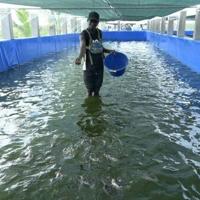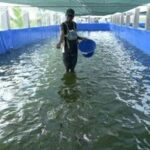The town of Kayar in Senegal is situated near the vast Atlantic Ocean, but it is an inland farm that contributes to its fish production.
The farm was founded by Khadidiatou Sar Seck around 15 years ago in this West African country, where fishing is a crucial part of the national identity.
Fish makes up over 70 percent of household protein intake, and the fishing industry supports around 600,000 jobs directly and indirectly in a population of 18 million people.
However, the once seemingly unlimited resource is now becoming scarce due to overfishing, illegal catches, and global warming.
The amount of catches by traditional wooden fishing canoes dropped by 58 percent between 2012 and 2019, according to the Environmental Justice Foundation (EJF).
With a high cost of living and widespread unemployment, Senegalese people are facing rising prices for fish, a staple food that is becoming less affordable.
Almost every day, there are reports of migrant boats leaving, being intercepted, or capsizing on the dangerous route between Senegal and Spain’s Canary Islands.
Many of those on these boats are fishermen or residents of the Atlantic coast, which heavily relies on the fishing industry.
With the new government, there is a commitment to promoting fish farming and attracting industry investments.
– Untapped potential –
“Our goal is for aquaculture to significantly contribute to the country’s marine production and help achieve food sovereignty,” said fisheries minister Fatou Diouf at a conference on sustainable aquaculture in the capital Dakar in September.
President Bassirou Diomaye Faye has made food sovereignty a key policy since taking office in March.
Despite its vast potential, Africa only accounts for around 1.9 percent of global aquaculture production, according to a 2024 report by the UN’s Food and Agriculture Organization (FAO).
Asia, on the other hand, accounts for 91.4 percent.
While aquaculture has been practiced in Senegal for a long time, it has struggled to flourish.
Although the country established a dedicated agency in 2006, aquaculture still only provides about one percent of the overall aquatic produce in Senegal.
For Seck, one of the challenges is that Senegalese people are not familiar with the product and finding quality varieties is difficult.
Imported feed for farmed fish is expensive, land access is challenging, and marketing is complex, she added.
Seck sells her products directly to individuals, wholesalers, and fishmongers.
However, the director of the national aquaculture agency, Samba Ka, has big plans for the industry.
“If we have investment and partners on board, anything is possible,” he said.
“We need everyone to participate, organize fairs and culinary workshops, invite chefs, so that people know this is a viable source of food that is beneficial for health and nutrition.”
– ‘No more fish’ –
The national agency aims to produce 65,000 tonnes of farmed fish by 2032 and create around 50,000 jobs.
In a large hangar about 100 kilometres southeast of Dakar, Demba Diop specializes in producing young fish for aquaculture.
He had to use his own funds to start the farm, as banks were unfamiliar with the business, he explained.
Challenges include the cost of feed and the availability of good quality young fish, both of which need to be imported from Europe.
At Dakar’s Soumbedioune market, fishermen who are pulling their colorful wooden boats ashore had mixed feelings about the prospects of aquaculture.
“We have plenty of fish in our seas, but unfortunately, foreign trawlers deprive us of it,” said Olivier Gomes, 36, who is not considering fish farming.
Gomes expressed concerns about price competition from farmed fish and is thinking about going to Europe for better earning opportunities.
However, Alioune Badara, a 54-year-old former fisherman who spent some time in Europe before returning to Senegal, is intrigued by the idea of aquaculture.
“Today, there are no more fish in the sea. If someone can financially help me with fish farming, I am very interested,” he said.
amt/lal/acc/js-jj





